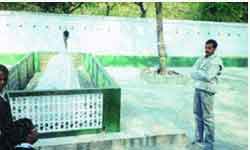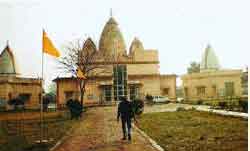
Dargah Naugazi,
an impressive grave 18 yards (16.2 metres) long, named after a pir (saint)
called Nuh Aleihi Salaam, is located in a narrow lane. Interestingly, Nuh is
believed to be Noah and the grave the famous Ark. Another interpretation is that
the mound perhaps was built over the remains of the Ark. The shrine, visited by
scores of devotees, has no independent custodian. Ram Milan, a devotee who makes
an offering every day, says that for him the dargah is no less than a temple. He
experiences a lot of mental peace when he visits the dargah. Ram Milan, like
most of Ayodhya's residents, is not interested in the background of the pir. And
like the rest, he is not the kind who would willingly desecrate a place of
worship. -- T.K.
Rajalakshmi
Photo:
Dargah of Sheesh Paigambar
By T.K. RAJALAKSHMI
 Two documentaries made by
Vidya Bhushan Rawat lead the viewer to a surprising tranquillity within Ayodhya,
which has a rich diversity of religious denominations and a long history of
their peaceful coexistence.
Two documentaries made by
Vidya Bhushan Rawat lead the viewer to a surprising tranquillity within Ayodhya,
which has a rich diversity of religious denominations and a long history of
their peaceful coexistence.
AYODHYA is more or less
synonysmous with strife and an unresolved issue in the context of the events of
December 1992, when kar sevaks brought down the Babri Masjid. However, what is
striking is that despite all these years of communal polarisation, particularly
around Ram Janmabhoomi, there seems to be a strange tranquillity within the town
and among its people, exemplified in the rich diversity of religions and history
of their harmonious coexistence over centuries.
The place by itself evokes no
hostility - if anything, there is remorse among those who may have partaken in
bringing down the Babri Masjid - and the people are emphatic that the problem is
not religion, but a specific brand of politics. In fact, why should religion be
a problem for the people of Ayodhya, asks Vidya Bhushan Rawat, an independent
film-maker and social activist, who has recently completed two documentary films
on the rich variety of religious denominations that exist
there.
What is left unsaid is an
uncomfortable fact and this is what Rawat does very revealingly. Through the
lens of his camera, he digs out that which is invisible to the public; he shows
that people are fed up with the continuous sense of tension in the town each
time the Vishwa Hindu Parishad (VHP) decides to launch a nationwide campaign on
the issue of constructing a Ram temple or each time the Bharatiya Janata Party
decides to make the temple an issue.
The two documentaries, which
have less in terms of narrative and more in terms of content and information,
were completed recently, after over one and a half years of research. Titled
Ayodhya Se Maghar Tak: Ayodhya Ki Sanskritik Viraasat (From Ayodhya till Maghar:
Ayodhya's Cultural Heritage) and Viraasat Ki Jung (The Struggle to Define a
Legitimate Heritage), the films detail the innumerable Sufi shrines, which,
unknown to many, have coexisted for centuries with Buddhist, Sikh and Jain
shrines. It is not a treatise on the religiosity of the place but more an
exposition on the history of coexistence among the people of Ayodhya. The
problem, as Usha Gupta, one of the persons interviewed, says, "has come from
outside", referring to political interference.
The Sufi shrines are well
maintained by the people and are visited by persons belonging to all
communities, including many people from the majority community. Ayodhya is also
called "Khurd Mecca" or the "Small Mecca" because of the presence of several
tombs or dargahs of Sufi saints.
Dargah Naugazi, an impressive
grave 18 yards (16.2 metres) long, named after a pir (saint) called Nuh Aleihi
Salaam, is located in a narrow lane. Interestingly, Nuh is believed to be Noah
and the grave the famous Ark. Another interpretation is that the mound perhaps
was built over the remains of the Ark. The shrine, visited by scores of
devotees, has no independent custodian. Ram Milan, a devotee who makes an
offering every day, says that for him the dargah is no less than a temple. He
experiences a lot of mental peace when he visits the dargah. Ram Milan, like
most of Ayodhya's residents, is not interested in the background of the pir. And
like the rest, he is not the kind who would willingly desecrate a place of
worship.
The films are not about the
beliefs of people. However, they reiterate that intolerance among the people is
not a natural trait but the outcome of a consciously cultivated process. For
instance, the Dargah of Sayyed Mohammad Ibrahim, named after a 17th century
figure, was fiercely protected by the local people, including several Hindus,
when its dome was attacked in December 1992. Sayyed Mohammad Ibrahim is believed
to have been born during the reign of the Mughal emperor Shah Jehan and ruled a
small principality. Influenced by Sufi teachings, he renounced his worldly
pursuits. According to local legend, he arrived in a boat, pictures of which are
depicted on his shrine. A large number of Hindu halwais, or confectioners, from
the Hanumangarhi area visit the shrine every Tuesday and makes offerings and
distribute prasad.
The Teen Darvesh dargah, whose
dome was also targeted by bigots in December 1992 after the demolition of the
Babri Masjid, is near Naugazi. No one knows the identity of the three saints
buried there but it has a large following coming from all
communities.
The most notable after Naugazi
is the dargah of Sheesh Paigambar. Considered one of the holiest shrines in the
town, some people believe the saint to be the son of Adam. There is a spot
called the Ganesh Kund, on the southern side of the grave, where devotees take a
dip. There appears to be no contradiction of faiths here.
In fact, there are several
features that are seen as protests against religious orthodoxies including
patriarchy. For instance, the dargah of Badi Bua located at a railway crossing
between Ayodhya and Faizabad, is one of the few dargahs of women in the area.
Badi Bua was the sister of Hazrat Khwaja Nasiruddin Chiragh Dehli, the spiritual
successor of the Hazrat Khwaja Nizammudin Auliya, the Chisti Sufi of Delhi.
Legend has it that she was a strikingly beautiful woman, who chose to serve God
by serving the poor. She faced a lot of opposition from the clergy, to which she
is supposed to have declared famously: Na Aalim Rahega, Na Zalim (There shall be
no place for either the cleric or the oppressor). Badi Bua's shrine is revered
by one and all.
THE film-maker has tried to
bring out the contrasts in the prevalent ethos of Ayodhya. In Viraasat Ki Jung,
while in one scene people are shown praying at the Ram Ghat in the calm waters
of the Sarayu at the break of dawn, there is another, of the Trishul Deeksha
ceremony of Pravin Togadia held in Delhi.
Maghar, where the poet-saint
Kabir is said to have spent his last days, is 150 km from Ayodhya. It is said
that the Brahmins of Ayodhya persuaded Kabir to turn to Kashi, where he could
attain moksha. Instead, he went to Maghar, which, it was believed, would turn a
person into a donkey in the afterlife. Kabir died at Maghar and there is a
structure dedicated to him on which his teachings are
engraved.
The people of Ayodhya can never
forget December 1992. "The Masjid was broken, there is no doubt about that. It
will be a matter of pride for the entire world if the locals rebuild it jointly.
Aaye di ke bawaal se log pareshaan ho gaye hain, rozi roti ka sawaal bana hua
hai (People are fed up with the vitiated atmosphere, they are more concerned
with issues of livelihood). The business class and the working class can no
longer tolerate the tense atmosphere in the district," says a local resident in
Viraasat Ki Jung. He says that the local people will oppose any organisation
seeking to inflame passions around the mosque and temple. At the Anees and
Chakbast Library in Faizabad district, there are some people who actually
express remorse at what had happened. Says one: "The Babri Masjid should not
have been brought down. But it happened." Then he clarifies that he had gone for
theparikrama but not for the demolition. Evidently, there is a feeling among the
people there that what happened was grossly wrong.
The sense of compositeness is
exemplified in Raj Rani's statement. A Dalit woman, she lives near the Dargah
Shaikh Shamsuddin Fariyad Ras, which is located in a prominent Hindu locality.
She says that the dargah is as important to her as Ram and that the Baba has
never failed her in times of distress. Similarly, the 700-year-old Dargah Bijli
Shaheed is revered by the Dalit family that lives in front of it. An upper-caste
family maintains the dargah of Makhdoom Shah Fateullah. Rajpal Singh, a member
of the family, does not associate the dargah with any religion. He says that
people visit it to cure themselves of ailments.
In Akbarpur district, formerly
part of Faizabad district, is the dargah of Kachhauchcha Sharif, deemed to be
the resting place of the famous Sufi Sayyed Ashraf Jahangir Samnani. Born in
1307 in Samnan province of Iran, he was motivated to travel to India by a Sufi
seer. Travelling through Samarkand and Bukhara, he went to Bengal and Jaunpur,
where he set up a Sufi centre. Samnani visited Ayodhya and breathed his last in
Kachhauchcha Sharif. This place attracts people from all denominations. It is
said that more Hindus than Muslims visit the shrine.
Similarly, the two famous Jain
temples in Ayodhya and the Gurudwara Brahmakund Sahib - where three prominent
Sikh gurus, including the founder of the Sikh religion, Guru Nanak, are known to
have preached - are symbolic of the peaceful coexistence of various communities
over the centuries.
There is also a strong Buddhist
influence in the Awadh region. Ayodhya was said to be the second most important
pilgrimage site after Shravasti, the capital of Koshal. Sacred Buddhist sites
such as Kushinagar, Sarnath and Shravasti were once part of the Awadh
province.
"Celebrate Ayodhya's cultural
heritage - do not destroy it" is the message of both the documentaries. Ayodhya
is much more than the birthplace of Ram, and the people of Ayodhya believe in
this.
There is some local history
attached to these shrines and it appears that the grip of orthodoxy has weakened
considerably over the years as people have experimented with other faiths. The
area has a history of rejecting orthodoxies, a practice that continues as people
flock to the Sufi shrines.
There are about 80 important
dargahs in Ayodhya town itself with several others spread over Faizabad
district. Rawat says that Ayodhya was known as Shahar-e-Auliya or the city of
Sufis. It is also the land of Mangal Pandey, who led the Meerut rebellion in
1857 and the famous vocalist Begum Akhtar; it is also the place where freedom
fighter Ashfaqullah Khan was hanged (the hanging took place at the Faizabad
Jail). It was in fact this heterogeneity that was attacked in December
1992.
Ayodhya's heritage is
multi-cultural and multi-religious, and this has to be recognised and preserved.
It is here that both the documentaries successfully show that the dominant forms
of showcasing places and people's opinions may not reveal everything and that
there is a lot that is unsaid, unheard and unseen.
Source: The Hindu, New Delhi




 Sultan Shahin
Sultan Shahin


0 comments:
Post a Comment